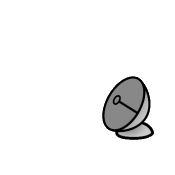
PicSat is orbitting the Earth at an altitude of about 600 km. At this altitude, the satellite is moving at about 8 km/s, and is completing an orbit in 90 minutes.
If you want to receive telecommunication packets from the satellite, you need to wait for it to be above your station, in direct visibility from your antenna. The period during which the satellite is above your local horizon, hence during which you can communicate with it, is called a pass. The number of passes you can expect every day, and their duration, are highly dependant on your station location and altitude. Stations close to the poles have more passes, which are also longer.
You can use the tool below to predict the next passes of PicSat above your station.
| Orbit Number | Pass Begins | Pass Ends | Maximum | Duration |
|---|---|---|---|---|
This is the map of the orbital trajectory of PicSat above the Earth, for the next 3 hours. Each black circle represents the position at the surface of the Earth directly below the satellite, taken at one minute intervals. The orange circle is the current position of the satellite.
The strange trajectory that you can see is due to the geometrical projection of the circular orbit on the map. Remember that PicSat is on a polar orbit! So when, near the pole, the satellite seems to abruptedly change direction, it is actually continuing on an almost straight trajectory right above the pole. It goes from the South pole straight to the North pole, passes above it to the other side of the planet, and then goes back to the South pole. And because the Earth is slowly rotating below the satellite, the orbits do not perfectly overlap each other, but drifts toward the West (the Earth is rotating from West to East).